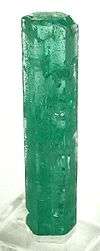La Lechuga
La Lechuga (English: The Lettuce) is a monstrance constructed, between 1700 and 1707, by José de Galaz.[1] La Lechuga was made for the San Ignacio Church of Bogotá, and paid for by a group of jesuits in order to hide the gems from the Spanish Crown.[2] Currently, La Lechuga is owned by the Bank of the Republic and it is on display at Bogotá's Colección de Arte del Banco de la Republica.
Creation
The making of the monstrance took seven years and three goldsmiths. It is widely believed that a group of Jesuits ordered La Lechuga to be sculpted in order to hide the gemstones from Spanish Crown during the New Kingdom of Granada. The Jesuits contracted the Spaniard José de Galaz who, with the help of two other goldsmiths, was able to build the monstrance between 1700 and 1707 at a price of $1,100 Reales, $100,000 USD in today's currency.[3] When José de Galaz finished smithing La Lechuga on 16 July 1707, he estimated its price to be $20,000 Reales, or $2,000,000 USD.[3]
Its name comes from the large amount of emeralds built into the monstrance, as the structure when completed, looked as green as a lettuce.
Disappearance
La Lechuga was held by the San Ignacio Church until 1767 until King Charles III of Spain ordered all Spanish possessions to be removed back to Spain. In an effort to avoid La Lechuga from falling to the Kingdom of Spain, the monstrance was taken into hiding by a group of Jesuits. Much is unknown throughout the time of its concealment, and it was not until 1985, that La Lechuga was seen again in public after Colombia's central bank, Banco de la Republica, bought it for $3,500,000 USD. Today, La Lechuga can be found on display at Bogotá's Colección de Arte del Banco de la Republica.[4]
Exhibition
The first time La Lechuga left the country was in 2015 where it was displayed at Spain's Museo del Prado between March 3 and May 31 of that same year.[5]
Between September 20, 2017 and January 15, 2018, the monstrance is on exhibition in the Louvre in Paris, alongside a statue of Pedro Laboria representing Saint Barbara.[6]
Description
The heliocentric treasure is a leading example of gold and silver eucharistic objects made for church altars in Catholic churches in South America particularly from colonial times.[7] It functioned to present the "host" consecrated to the faithful, as part of the liturgical ritual where it is carried in procession during the Feast of Corpus Christi for adoration by the faithful. As a sculpture, it has both high and low relief modeling.
As a typical monstrance in form, the highly ornate La Lechuga comprises a cross-crowned disc making a circular frame for the wafer, supported by an angel and knobbed stem for firmly holding aloft, allowing the faithful to see the sacrament. The whole item weighs 4.9 kilograms (10 lbs 13 oz).[7]
The main disc is an elaborate circular form with undulating rays symbolizing the sun. From the centre outwards, baroque pearls immediately surround the space for the host in turn surrounded by waved gold spikes and four tiers of mostly square-cut emeralds. A thick garland of green enamelled vineleaves with amethyst grapes festoon 20 more undulating rays, each topped by a pearl. Interspersing these, 22 major sunbeams end in radiating sun discs in gold and emeralds.[4] The whole circular schema is topped by an emerald cross and below is supported by an angelic "Atlas" figure in a tunic and flowing drapery in celestial blue and green enamel. The angel sports golden Caligae (open Roman boots), and above its head on the front is the single yellow sapphire; on the verso side is a large, square and high quality amethyst.[4]
Knobbed for a secure hand grip,[4] the stem is styled like a fountain dripping emerald streams, to an amethyst-studded base supported on an eight-lobed, footed stand. Zoomorphic forms[4] (vines and creatures) are densley packed low relief gold modelling resembling a paradise.
According to the current owners, it is considered one of the "richest and most beautiful religious jewels"[7] in Spanish America, and testifies to an interpretation of the Baroque in the "land of goldsmiths". Further, it shows how this artistic style found new dimensions in a territory where gold and emeralds were abundant, while it was still possible to display indigenous culture while the foremost goldsmith of the continent was still alive.[7]
Jewels
Besides the main frame being composed of 8,850.3 grams (312.19 oz) of 18 carat gold,[8] La Lechuga also contains the following gemstones:[8]
References
- "'La Lechuga' va al Prado".
- "LA RARA HISTORIA DE LA LECHUGA". eltiempo.com.
- http://www.eltiempo.com/archivo/documento/MAM-357237
- BANCO DE LA REPÚBLICA - 2015 interactive photo details provided in Spanish {http://www.banrepcultural.org/la-lechuga/explore/]
- "La obra invitada: Custodia de la Iglesia de San Ignacio de Bogotá".
- "Année France-Colombie 2017Deux chefs-d'oeuvre de l'art baroque de Bogotá au Louvre | Louvre". Louvre (in French). 2017-08-25. Retrieved 2017-10-13.
- "La Lechuga" Goes to the Prado – press release in Spanish
- "La Lechuga".
